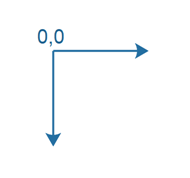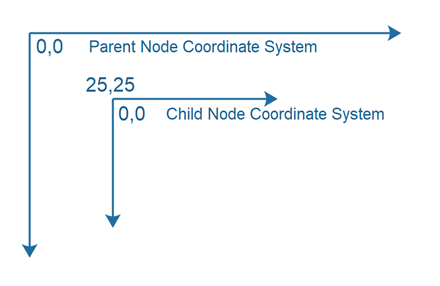JavaFX Node
Jakob Jenkov |
The JavaFX Node class, javafx.scene.Node, is the base class (superclass) for all components
added to the JavaFX Scene Graph. The JavaFX Node
class is abstract, so you will only add subclasses of the Node class to the scene graph. All JavaFX Node
instances in the scene graph share a set of common properties which are defined by the JavaFX Node class.
These common properties will be covered in this JavaFX Node tutorial.
JavaFX Node Basics
Each JavaFX Node (subclass) instance can only be added to the JavaFX scene graph once. In other words, each Node instance can only appear in one place in the scene graph. If you try to add the same Node instance, or Node subclass instance, to the scene graph more than once, JavaFX will throw an exception!
A JavaFX Node can sometimes have subitems - which are also called children. Whether a given Node instance
can have children or not depends on the concrete Node subclass. A special subclass of JavaFX Node named
Parent is used to model Node instance which can have children. Thus, Node instances that can
have children are typically children of the Parent class - and not the Node class directly.
The JavaFX Stage and JavaFX Scene classes are not subclasses of the JavaFX Node class. While these two classes are used to display the JavaFX scene graph, only Node instances added to a JavaFX Scene instance are considered part of the JavaFX Scene graph.
Once a Node instance is attached to the scene graph, only the JavaFX Application Thread, the thread managing the JavaFX scene graph, is allowed to modify the Node instance.
JavaFX Node Properties
The JavaFX Node class, and thus all subclasses of Node, has the following common properties:
- A cartesian coordinate system
- A bounding box delimited by:
- Layout bounds
- Bounds in local
- Bounds in parent
- layoutX
- layoutY
- Preferred height
- Preferred width
- Minimum height
- Minimum width
- Maximum height
- Maximum width
- User data
- Items (Child nodes)
Each of these properties will be covered in subsequent sections.
JavaFX Node Coordinate System
Each JavaFX Node has its own cartesian coordinate system. The only difference from a regular cartesian coordinate system is that the Y axis is reversed. That means, that the origo of the coordinate system is in the upper left corner of the coordinate system. As Y values increase, the point moves down from the top of the coordinate system. This reversal of the Y axis is normal in 2D graphics coordinate systems.

It is possible for a JavaFX Node to have negative X and Y coordinates.
Each Node has its own coordinate system. This coordinate system is used to position child Node instances within the parent Node, or when drawing on a JavaFX Canvas. That means, that a Node that is a child of another Node both has its own coordinate system, and a location (X,Y) within its parent Node's coordinate system.
Below is an example of a parent Node coordinate system in which a child Node is located at (25,25) in the parent Node coordinate system. The child Node also has its own coordinate system which has its (0,0) where the child Node is located in the parent coordinate system - meaning at (25,25) in the parent Node coordinate system.

JavaFX Node Bounding Box
A JavaFX Node has a bounding box. The bounding box of a JavaFX Node is a logical box around the shape of the Node. The full Node is located inside the bounding box - graphically that is. In other words, all corners and edges of the Node is contained within the bounding box, and there is no extra space around the Node, unless added via an effect, padding or something else applied to the Node.
Actually, a Node has 3 bounding boxes:
| Name | Description |
|---|---|
| layoutBounds | The bounds of the Node in its own coordinate space - without any effects, clip or transformations applied. |
| boundsInLocal | The bounds of the Node in its own coordinate space - with effects and clip applied, but without transformations. |
| boundsInParent | The bounds of the Node in its parent coordinate space - with effects, clip and transformations applied. |
Each of these bounding box dimensions can be read from their corresponding properties with the same name, meaning
properties named layoutBounds, boundsInLocal and boundsInParent.
The boundsInParent bounding box is used by the parent Node (Parent) to layout its children.
The parent Node needs to know the total space including all effects, clip and transformations of a Node in
order to be able to allocate space for it.
layoutX and layoutY
The layoutX and layoutY properties of a JavaFX Node object contain the X and Y of
the Node inside of its parent. In other words, layoutX and layoutY are the offsets from the 0,0 (origo) of
the parent Node.
Not all layout classes will respect the layoutX and layoutY of a Node. It depends on what the exact layout algorithm of the parent Node is.
node.setLayoutX(100); node.setLayoutY(200);
Preferred Width and Height
The preferred width and height properties of a JavaFX Node object specify the preferred width and height of the given Node object (subclass of Node normally). Not all parent Node classes will respect the preferredWidth and preferredHeight of a child Node. It depends on the concrete parent Node implementation.
node.setPrefWidth(100); node.setPrefHeight(100);
Minimum Width and Height
The minimum width and height properties of a JavaFX Node object specify the minimum width and height a Node wants (or needs) to display itself. Not all parent Node classes may respect these properties. It depends on the concrete parent Node implementation.
node.setMinWidth(50); node.setMinHeight(50);
Maximum Width and Height
The maximum width and height properties of a JavaFX Node object specify the maximum width and height a Node wants (or needs) to display itself. Not all parent Node classes may respect these properties. It depends on the concrete parent Node implementation.
node.setMaxWidth(50); node.setMaxHeight(50);
User Data
You can set user data on a JavaFX node using the setUserData() method. This method takes any
Java object of your own choosing. This way you can attach e.g. business objects to JavaFX Node instances.
Here is an example of attaching some user data to a Node instance:
node.setUserData(new MyObject("Hey - some data"));
Items or Child Nodes
Many JavaFX Node subclasses can contain items or child nodes. How exactly you add and access these child Nodes
depends on the concrete Node subclass. Some classes have a getItems() method returning a List
of the items. Other classes have a getChildren() method doing the same. You will have to check
the concrete Node subclass to find out if it can have items or child nodes, and how you add and access them.
| Tweet | |
Jakob Jenkov | |











